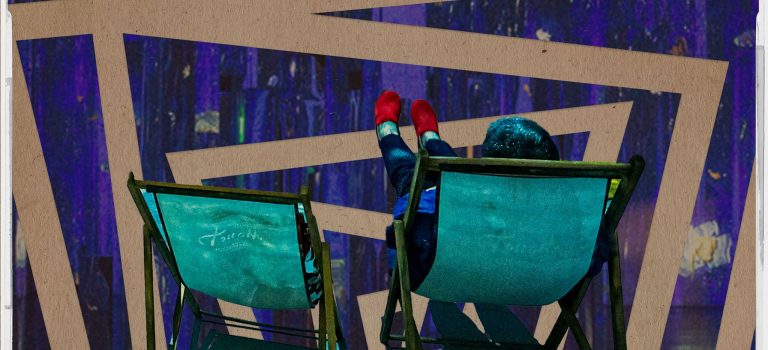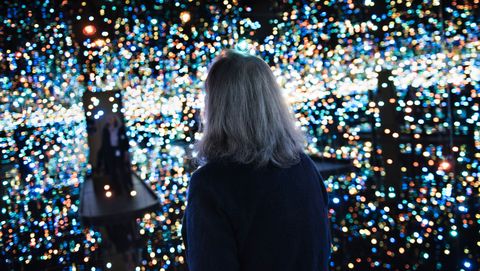Source: shondaland.
Stimulation of the senses is part of the attraction of public displays of art, and the phenomenon continues today, most notably with the ever-growing field of immersive art experiences.
When the first art exhibitions were staged in Paris and London in the 17th and 18th centuries, attendees reported feeling sensory overload. “These were immersive for viewers,” says Catherine Roach, an associate professor of art history at Virginia Commonwealth University. “The paintings and sculptures were displayed floor to ceiling so people were surrounded by paintings, and they tipped [the paintings] forward slightly so the glare from the daylight wouldn’t wash them out. People reported being overwhelmed, distracted, and not knowing where to look.”
That stimulation of the senses, Roach says, is part of the attraction of public displays of art, and the phenomenon continues today, most notably with the ever-growing field of immersive art experiences. They’re not new — the artist Yayoi Kusama debuted her first Infinity Mirror Room back in 1965, but immersive art experiences are becoming more and more common for institutions and viewers alike. Some are held in traditional venues, like galleries and museums, while others make use of unconventional spaces like abandoned storefronts. And while immersive art can employ materials that’ve been used for centuries like plaster, wood, and glass, these experiences have increasingly become synonymous with digital, where guests are bathed in video projections like a sort of 360-degree IMAX trip. As they become more commonplace, immersive art experiences aren’t so much changing what an art exhibition is as they are disrupting how the public interacts with art and raising questions about the lines between what is art and what is pure entertainment.
One of the best examples is the “Immersive Van Gogh” experience — or, rather, experiences with an “s”; at least five private companies have created large-scale, walk-through projections based on the Dutch painter’s work, a phenomenon that’s gone viral after gaining popularity during its debut in Paris. “There is discourse about whether it helps or hinders consumption of van Gogh in museums,” Roach says. “There are always those questions for those who are stewards of art.”
In Los Angeles, “The Original Immersive Van Gogh Exhibit” takes place inside the former home of Amoeba Music in Hollywood, a roughly 20,000-square-foot space that would’ve been chopped and screwed into something else by developers had experiential art and entertainment group Impact Museums not stepped in with a proposal. Experiencing the show is almost like walking through a haunted house, except, instead of ghouls and chain saw-wielding freaks, guests first see a swirl of neon lights in a darkened hallway and then a gigantic room where projections of van Gogh’s work fill the room. (That is, after you walk through a metal detector, a bar area, and a short synopsis of van Gogh’s short career as a struggling artist.) When this writer attended, about 30 people (wearing masks) sat in stunned silence on the floor or benches as a digital film played with soaring orchestral music in the background. The life of van Gogh, who barely made a living as a painter and, of course, suffered from mental illness toward the end of his life, was neatly summarized in a beautiful and sometimes haunting swirl of images, including his most famous works, Irises, Sunflowers, and Starry Night. It lasted about 30 minutes. Tickets start at $39.99, and, on the way out, guests pass through the gift shop, where they can purchase van Gogh-inspired seat cushions, mugs, umbrellas, and the like.
It would be lazy and predictable to say something like this cheapens van Gogh’s art. After all, anything that gets people to engage with art is good, and turning up one’s nose at so-called pedestrian forms of art has been done so much, it’s sort of passé. When photography emerged as a new form, people predicted that medium would kill painting. Before that, when the first museums opened, Roach says, “There was concern about recontextualizing works — asking what does it mean to take art out of churches and put pieces into museums.”
Diana Rayzman, a cofounder of the Impact Museums group that puts on this show in partnership with Lighthouse Immersive, has of course heard critiques that the show might be “dumbing down” van Gogh or that it isn’t real art. But she asserts that the van Gogh experience is not meant to replace the traditional museum method of seeing the artist’s work. “We’re not competing with museums,” she says. “This is a different type of storytelling.” Indeed, with its companion app that lets guests scan a QR code to learn more about van Gogh and the ephemeral audio piped in of van Gogh’s “voice” sharing thoughts from his subconscious, the project scales sensory heights ordinary galleries simply can’t, and the proof is in the receipts. At least two million people have seen the exhibit in various cities already.
Yet for all that immersive experiences like this one offer, they have shortcomings too. Our brains have an uncanny ability to imagine and create with just basic stimuli. That’s why movies based on a book almost always fail to match the thrill of actually reading the book, because we have to bring something to reading a book; our brains fill in gaps. It’s participatory. It’s the same thing with standing in front of a painting and getting lost in it.
An immersive digital experience doesn’t offer the same type of engagement. You don’t have to do anything. Likewise, at a gallery or museum, there are typically placards explaining what the work is about, how it was made, what was on the artists’ mind. This information can be found at the van Gogh immersive experience by using a QR code to open a catalog, but those who don’t actively seek this information are essentially just looking at pictures without much context. And then there’s the matter of price. Galleries are often free, and while you probably won’t see a van Gogh painting in a local gallery, museums often offer opportunities to see exhibitions at a reduced cost or for free. Rayzman says that the van Gogh exhibit does offer free tickets to schools and other groups (they even feature work from homeless artists in the gift shop, with proceeds going to the artists and women’s shelters), but shows like these do indeed place a line between who gets to see the work and who doesn’t. None of these observations makes these experiences “bad,” per se, but they do prompt questions about what art is supposed to do, how we should engage with it, and who gets to see it. As with everything in the 21st century, there are things we give up when we digitize analog experiences.
Agnieszka Pilat, an artist whose “Renaissance 2.0” exhibition blends modern painting technique with technology, hasn’t seen the immersive van Gogh experience but says we should all be looking to embrace technology rather than fear it. An artist in residence at the engineering and design company Boston Dynamics, she got inspired after hanging out with those insane-looking robot dogs that can dance and climb like humans; “Renaissance 2.0” has her painting machines in the style of the old masterworks but with a twist: By holding your phone to the paintings, augmented reality and AI inside the canvas makes them move. “Any time man wants to do something extraordinary, he builds a machine,” she says. “Ultimately, machines are our friends and allies.” Her dream, she says, is for intelligent machines to one day come see paintings and say, ‘These are by our ancestors.’”
That may be a way off, or a fantasy that’ll remain fodder for sci-fi flicks, never to materialize in the real world. But artists like Pilat are most likely bellwethers for the future. Art, she says, is always about who holds power, and right now, tech is power. Traditional forms won’t disappear; they’ll just adapt. “[Artists] will innovate,” she says. “We’ll have to step up our game to compete. The obstacle becomes the way.”










